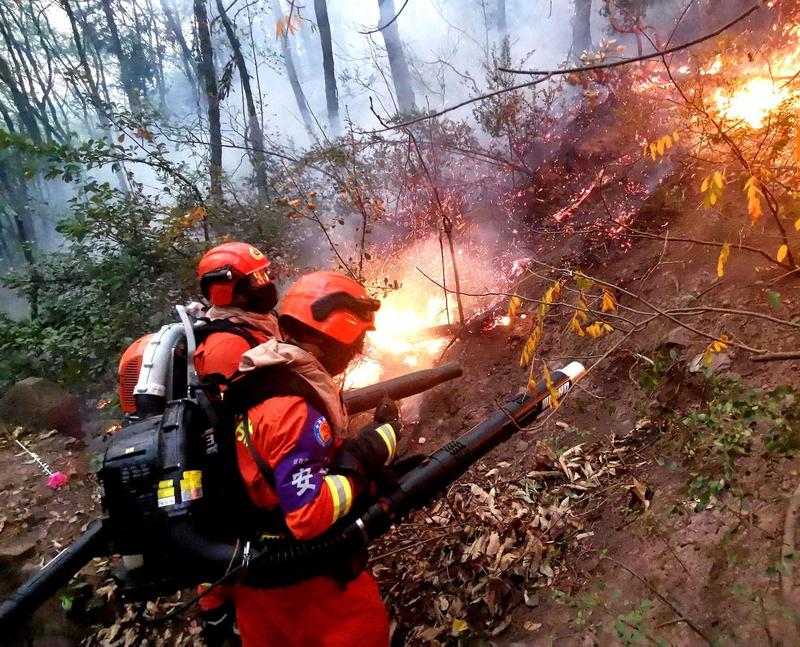 Firefighters attack flames in the forest of Xichang, Sichuan province, on Wednesday. (ZENG YONG / FOR CHINA DAILY)
Firefighters attack flames in the forest of Xichang, Sichuan province, on Wednesday. (ZENG YONG / FOR CHINA DAILY)
Wearing dust-covered clothes, firefighters napped outside a Buddhist temple, either lying on the ground or leaning against the wall. Some of them held bottles of water.
Nobody knows how long they will be able to rest.
Like their colleagues in other parts of the country, the firefighters are seemingly destined to be busy this spring amid a grimmer forest and prairie fire control situation
A raging forest fire they were battling in Xichang county, Sichuan province, which began at around 4 pm on Monday and killed 19 people who were fighting it on Tuesday, was visibly extinguished around 1:30 pm Wednesday thanks to the efforts of about 2,300 people.
Extinguishing the flames on the side of the mountain prevented the blaze from spreading and endangering the 1,100 year-old Guangfu Buddhist Temple and the Liangshan Yizu Slave Museum on the mountain.
However, like their colleagues in other parts of the country, the firefighters are seemingly destined to be busy this spring amid a grimmer forest and prairie fire control situation.
Spring is the season with the highest occurrences of forest and prairie fires in China. In the past five years, almost 70 percent of major fire disasters occurred during the season, according to a recent circular published by three central government bodies, including the Ministry of Emergency Management.
 People outside a funeral house in Xichang, Sichuan province, on March 30, 2020 bid farewell to 19 firefighters who died earlier while trying to put out a forest blaze. (YIN GANG / FOR CHINA DAILY)
People outside a funeral house in Xichang, Sichuan province, on March 30, 2020 bid farewell to 19 firefighters who died earlier while trying to put out a forest blaze. (YIN GANG / FOR CHINA DAILY)
The situation this year, however, is even grimmer. Some of the country's key forested areas are expected to experience drought, and the amount of flammable materials in these areas has peaked after accumulating for dozens of years.
"The high risk of forest and prairie fires will linger. The prevention and control situation is increasingly grimmer," the ministry said in a media release.
In the ministry's latest effort to tackle the situation, it has demanded firefighters station themselves in areas prone to fires rather than standing by in their bases.
Li Hu is a firefighter with the forest and prairie fire rescue team based in Chifeng, Inner Mongolia autonomous region. The 24-year-old has been on missions outside Inner Mongolia for over two weeks.
The first task he got was to help put out a forest fire in Wutai county, Shanxi province. After putting out the fire following a sleepless night, he and his colleagues soon rushed to Yushe county for another task.
"We were so rushed that, after we put out the fire, we only had a pack of instant noodles before leaving for Yushe," he said.
ALSO READ: Fire danger worse than last year in many regions
They hardly had time to eat during the four days they spent in the two counties.
"We usually took some time to fill our stomachs on our way to a new point," he said.
Now Li and about 250 of his colleagues are in Pingshan, Hebei province, to watch out for fires in nearby regions.
After the two tasks in Shanxi, An Jun, a commanding officer with the forest and prairie fire rescue team based in Xilin Gol league in Inner Mongolia, traveled to Xinzhou, also in Shanxi, with about 100 firefighters to facilitate local fire control work.
He said the differences in landforms between Inner Mongolia and Shanxi has posed some challenges for them.
"The mountain slopes are much steeper here," An said. "Some of them even have inclines of over 60 degrees. They are hard to climb."
He said, however, they are now doing some exercises especially designed for local conditions in Shanxi to enhance their firefighting capabilities.
READ MORE: Xi calling for more effort to curb disasters
The team will also invite members of local fire rescue teams to give lectures to help them learn more about local conditions. They will join local firefighters in patrolling if needed as ceremonial sacrificial activities increase with the approach of Tomb Sweeping Day, which falls on Saturday this year.
According to the Ministry of Emergency Management, the majority of forest and prairie fires with identified causes in the past 10 years in the country are caused by human factors, and ceremonial sacrifice is the top cause.
Huang Zhiling contributed to this story.


